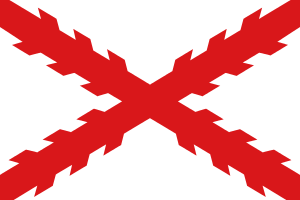Rafael Izquierdo y Gutiérrez
| Rafael Izquierdo y Gutiérrez | |
|---|---|
| Born |
Rafael Gerónimo Cayetano Izquierdo y Gutiérrez September 30, 1820[Note 1][1][2] Santander, Spain |
| Died |
November 9, 1883 (aged 63)[3] Madrid, Spain |
| Other names | Rafael de Izquierdo |
| Known for | Governor-General[4] of the Philippines from April 4, 1871 - January 8, 1873 |
| Parent(s) |
Antonio Izquierdo del Monte Antonia Gutiérrez de la Cámara |
Rafael Gerónimo Cayetano Izquierdo y Gutiérrez[5] (September 30, 1820[Note 1] – November 9, 1883)[1][3] was a Spanish Military Officer, politician, and statesman. He served as Governor-General of the Philippines from April 4, 1871 to January 8, 1873. He was famous for his use of "Iron Fist" type of government, contradicting the liberal government of his predecessor, Carlos María de la Torre y Navacerrada. He was the Governor-General during the 1872 Cavite mutiny which led to execution of 41 of the mutineers, including the Gomburza martyrs. Izquierdo also acted as Governor-General of Puerto Rico[2] from March 1862 to April 1862.
Early life
Izquierdo was born on September 30, 1820[Note 1] in Santander, Spain to Antonio Izquierdo del Monte and Antonia Gutiérrez de la Cámara. He was baptized Rafael Gerónimo Cayetano by Isidro Sánchez on the same day.[1][3]
Entering as a cadet in the regiment of infantry of Gerona, Rafael Izquierdo reached the military rank of captain[6][7] by the age of 17[8] when he participated in the First Carlist War in Navarre. At the start of the Second Carlist War which took place in Africa, Izquierdo was already a lieutenant colonel and at the end of the war brigadier general. He was then assigned to Lugo, Spain as military governor in 1861. The following year he was assigned as lieutenant-general to Puerto Rico before becoming an interim Governor-General when Rafael Echagüe y Bermingham vacated the position. Izquierdo then went back to Spain until in 1868 when he supported the revolution in Andalusia[9] and was tasked as deputy for Malaga and Alicante[10] in 1869 until 1871.
Philippine Governorship

Replacing General Carlos María de la Torre on April 4, 1871, Rafael Izquierdo[11] was installed as Governor-General of the Philippines. He is responsible for opening of steamship[12] and telegraph lines in the country.
He was also, known to have promptly, rescinded the liberal[13] measures thus implementing harsher laws,[5][14] which ignited an uprising.[15] The reformation suggested, that the soldiers, of the Engineering and Artillery Corps, should pay taxes which, they were previously, exempted from. Another, drastic change was the requirement to perform manual labor. These changes eventually, lead to the 1872 Cavite mutiny, where around, 200 soldiers, of the Engineering and Artillery Corps revolted and killed their officers; in retaliation, a lot of, liberals were implicated in the involvement of the conspiracy. The Spanish military court[16] condemned the martyred priests, Fathers José Burgos, Mariano Gómez and Jacinto Zamora (Gomburza) to capital punishment, by means of the garrote, on February 17, 1872. This uprising, later, lead to delays in rebuilding Malacañan Palace and in turn, almost, transferred, colonial governance back, within the walls, of Intramuros[17] for security purposes. The plan to transfer the colonial government to Intramuros ended, when Izquierdo fell ill and he stepped down from his position on January 8, 1873.
Rafael Izquierdo later, spent the remaining years of his life in Madrid, Spain, where he died in 1882.
See also
- Philippine revolts against Spain
- 1872 Cavite mutiny
- History of the Philippines (1521–1898)
- Freedom of religion in the Philippines
Notes
- 1.^[Note 1] One source says September 24, 1820 as his date of birth.<ref name="andalucia"/
the book says he became the governor general in 1870.
References
- 1 2 3 Rafael Gerónimo Cayetano Izquierdo's Baptismal Register
- 1 2 "Governors". World’s Statesmen. Retrieved 2010-01-19.
- 1 2 3 Diccionario biográfico de parlamentarios de Andalucía, 1810-1869: H
- ↑ "Spanish Administration (1565 - 1898)". Philippines Archipellago. Retrieved 2010-01-19.
- 1 2 Karnow, Stanley (1989). "Rafael de Izquierdo". In Our Image: America's Empire in the Philippines. Random House. ISBN 978-0394549750.
- ↑ Guía de forasteros en Madrid para el año de 1861.
- ↑ Emma Helen Blair, James Alexander Robertson: The Philippine Islands 1493-1898.
- ↑ Duka 2010, p. 106
- ↑ Gregorio de la Fuente Monge: Los revolucionarios de 1868: élites y poder en la España liberal.
- ↑ Congreso de los Diputados de España: Archivo histórico de diputados.
- ↑ "El movimiento propagandístico". Proyectos Saludas. Retrieved 2010-02-03.
- ↑ "Governors of the Philippines during the Spanish colonial period". Zamboanga.com. Retrieved 2010-01-19.
- ↑ "The Philippines as a Spanish Colony". Philippines-Archipelago. Retrieved 2010-01-19.
- ↑ "Rafael A-Vicente". Trophort. Retrieved 2010-01-19.
- ↑ Chandler, David P. In search of Southeast Asia: a modern history. University of Hawaii Press. ISBN 0-8248-1110-0.
- ↑ "Nationalist Movement and Katipunan Rebellion 1834 - 1897". University of Alberta. Retrieved 2010-01-19.
- ↑ "The Making of Malacañang". Retrieved 2010-01-19.
| Government offices | ||
|---|---|---|
| Preceded by Carlos María de la Torre |
Governor-General of the Philippines April 4, 1871 – January 8, 1873 |
Succeeded by Manuel MacCrohon |
| Preceded by Rafael Echagüe |
Acting Governor of Puerto Rico March 1862 – April 1862 |
Succeeded by Félix María de Messina e Iglesias |

.svg.png)